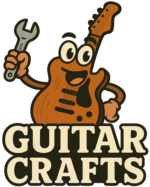Picking out the right wood for your electric guitar kit is exciting, but it can also feel confusing with so many options. Your choice doesn’t just affect how your guitar looks — it influences the feel, weight, and playability of your instrument, and it can make the build process easier or trickier depending on the species.
In this guide to wood choices for electric guitar kits: expert recommendations, I’ll break down the most common options you’ll see, how they perform in kit builds, and which ones are best suited for different styles of players. By the end, you’ll know how to select the right wood for your build — and you’ll end up with a guitar you’ll actually enjoy playing.
** Here’s a little transparency: Our website contains affiliate links. This means if you click and make a purchase, we may receive a small commission. Don’t worry, there’s no extra cost to you. It’s a simple way you can support our mission to bring you quality content.**
As an Amazon Associate, I earn from qualifying purchases.
Why Wood Choice Matters for Kits
Unlike acoustic guitars, electric guitars don’t rely entirely on the body wood for sound projection. Still, wood plays a major role in feel, sustain, and resonance. It also determines:
-
Weight: A heavy mahogany guitar feels different than a lightweight alder one.
-
Workability: Some woods are easier to route, sand, and drill if you’re building for the first time.
-
Durability: Certain neck woods, like maple, are naturally more stable.
If you want to explore the sound side of the equation in detail, check out my guide on the effects of different wood types on electric guitar tone.
The Most Popular Woods in Guitar Kits
Here are the woods you’ll see most often when shopping for a kit:
-
Alder: Lightweight, balanced tone, easy to work with. Often used in Strat-style kits.
-
Mahogany: Heavier, warm, and sustaining. A staple in Les Paul-style kits.
-
Ash (swamp or hard): Swamp ash is lighter and airy; hard ash is denser with more punch. Great for Tele-style builds.
-
Basswood: Affordable, lightweight, and neutral-sounding — common in beginner kits.
-
Maple (necks/tops): Bright, snappy, and strong. Often paired with alder or mahogany bodies.
-
Rosewood (fingerboards): Smooth under the fingers and warmer-sounding than maple.
Sound and Playability at a Glance
Here’s how they compare when building:
-
Alder: Comfortable, clear, and versatile.
-
Mahogany: Thick, warm, with singing sustain (heavier weight).
-
Swamp Ash: Bright, twangy, and resonant.
-
Basswood: Lightweight, neutral, and easy to cut.
For necks:
-
Maple necks/fingerboards: Snappy and bright.
-
Rosewood fingerboards: Softer feel and warmer tone.
Necks and fingerboards are just as big of a deal. Maple necks give you extra brightness and snap, while mahogany necks lean smoother and more rounded. Rosewood fingerboards keep things feeling mellow under your hands, and maple fingerboards give more crisp attack.
Classic Combinations That Work
Some woods just pair naturally well together in DIY kits:
-
Alder body + maple neck → clear, punchy tones (Fender-style builds).
-
Mahogany body + maple top + mahogany neck → rich, sustaining Les Paul style.
-
Swamp ash body + maple neck → bright, spanky, and resonant (Tele-style builds).
-
Basswood body + maple neck → lightweight and flexible for modern styles.
Practical Considerations Before Choosing
-
Workability: Basswood and alder are very beginner-friendly.
-
Weight: Mahogany and hard maple are heavy; alder and basswood are lighter.
-
Finish: Ash and mahogany look great with oil finishes; maple and basswood take paint and gloss well.
-
Climate: Maple and mahogany hold up well against humidity swings.
If you’re just starting your first kit, my list of tools needed for building an electric guitar kit will help you prep your workspace before tackling different woods.
FAQs About Wood Choices
What is the best wood for guitar kits?
There’s no universal “best.” Alder and swamp ash are popular for balance; mahogany is warm and sustaining; basswood is lightweight and easy to work with.
Which wood is better for a beginner?
Alder and basswood are excellent for first-time builders since they’re forgiving and lightweight.
Is alder or mahogany better?
Alder is versatile and lighter, while mahogany is thicker and warmer. It depends on your style.
Maple vs. rosewood fingerboards?
Maple is bright and snappy; rosewood feels warmer and smoother. Both work great — it’s about feel.
If you play with a lot of clean, percussive styles and want high-end sparkle in your sound, maple is the way to go. If you love midrange warmth or use a lot of gain, rosewood’s smooth character keeps things from getting too sharp and brittle. Maple brings a crisp bite under your hands, while rosewood softens those edges for long, comfortable playing sessions.
On A Personal Note: (no pun intended)
When it comes to buying or building my own electric guitars, I’ve always followed three simple rules I came up with years ago:
-
The guitar has to look good.
-
The guitar has to feel good.
-
The guitar has to sound good.
If it doesn’t check all three boxes in my book, chances are I’ll never want to pick it up and play it.
Final Thoughts…
Choosing wood for your electric guitar kit is less about “best vs worst” and more about what fits your needs: tone preference, build experience, and play style. If you want to go deeper into tone shaping after your build, you can explore topics like using tone pots and capacitors to sculpt your sound or adjusting pickup height for optimal sound on your guitar.
At the end of the day, pick the wood that feels right under your hands and inspires you to play. The perfect guitar is the one you love building, hearing, and holding.
There are 100’s of ways you can build a business around your passion for guitar building.
Check it out…


